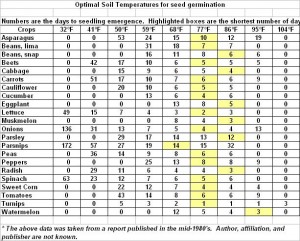To know when to plant, take your soil’s temperature.
Soil – not air – temperature is the trigger for seed germination. Soil temperature changes gradually. Factors that affect the process include the soil’s exposure to sunlight, its texture, moisture content and surface level (low-lying, flat or mounded).
Gardeners can expect particular soil temperatures to bring particular results. Most cool-loving garden vegetables germinate only when the soil reaches an average 45 degrees. Seeds for warm-loving plants wait until typical temperatures are 55 F.
The only sure way to know when it’s safe to plant is to take the soil’s temperature.
Buy a metal probe thermometer with a flat dial that provides low readings (in other words, NOT an oven-temperature meat thermometer, although it looks similar). These relatively inexpensive items are available at some garden stores, as well as many auto supply stores and discount store automotive sections. The car folks use them to check how well air conditioners are cooling.
Plan to take your garden’s temperature between 10 and 11 a.m. – the midpoint between when daily temperatures are coolest (dawn) and warmest (late afternoon).
Push the thermometer 1.5 to 2 inches into the soil at several locations. Its metal shaft will keep the thermometer from breaking if it hits a below-ground rock.
Do NOT leave the thermometer in the ground. Store it indoors between readings.
A strong, long-lasting cold front can take soil temperatures down again, especially just after they’ve finally warmed to 45 or 55 F in spring. Because soil temperatures tend to rise and fall so slowly however, a reading of 45 or 55 degrees usually means it’s safe to plant.
Being planted too early isn’t always fatal for seeds. Many will simply sit and wait for the soil to warm up. But with warm-loving crops in particular, the seeds may not stay viable for very long. If they do germinate, their delay may affect the plants health or output.
I use this digital soil thermometer. It is easy to read with its digital display and it only takes about 30 seconds to stabilize and record my soil temperature. It’s really nice to have this soil information verified so quickly and easily.
The table shows optimal soil temperatures for various seeds. 

